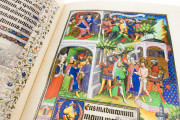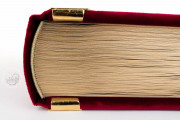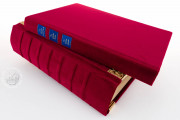The Sobieski Hours is one of the most elaborately decorated books of hours produced in fifteenth-century Paris. Painted in the 1430s and 1440s by the Bedford Master working with assistants, the Fastolf Master, and the Master of the Munich Golden Legend, the Christian prayer book boasts a decorative program that includes sixty exquisite large miniatures in the International Style. Each miniature comprises several scenes that engulf a few lines of text. The book owes its nickname to John III Sobieski, King of Poland, who owned the manuscript in the seventeenth century.
The Sobieski Hours is a pinnacle of Late Gothic Parisian illumination. By around 1430 some of the most skilful illuminators working in the style of the Bedford Master were at work on it. For more than a quarter of a century, the Bedford Master was one of the most prominent illuminators anywhere, and many who aspired to imitate him followed his style.
Because there are a great number of miniatures in the Sobieski Hours, the Master did not paint all of them, but he either composed them or transmitted models to his assistants.
With such an extensive program it was usual for the work to be shared. The equally talented Fastolf Master and his assistants, as well as the Master of the Munich Golden Legend, also made considerable contributions to the decoration of this large commission.
Sixty Miniatures Illuminated in the finest technique
The Sobieski Hours offers sixty full-page miniatures and more than four hundred perfectly composed scenes. Like Old Master panel paintings, they contain an extraordinary cornucopia of details, which the reader must first absorb in order to understand in full.
The Bedford Master did not simply oversee the depiction of a single Biblical event, but instead tells a complete story with exceptional artistic virtuosity. The narrative always begins at the top left and unfolds clockwise around a central event.
Sobieski Hours: Collaborative Work of Three Masters
A single illuminator could never have created such a monumental work of art as the Sobieski Hours without assistance. Just as the Très Riches Heures was the work of illuminators who collaborated over several decades, the Sobieski Hours was produced over an extended period of time by leading masters of the age.
As well as work in the finest Parisian style of the Bedford Master, miniatures were executed by talented emulators, producing some of the best work of the earlier fifteenth century.
Carefully modeled drapery and varied figure types with individualized expressions are characteristic of the Bedford style and are engagingly interpreted in the more than 400 scenes contained within the sixty miniatures of the Sobieski Hours.
A second prominent artist, known as the Fastolf Master, who worked in Paris and in Normandy, collaborated with the Bedford Master and often based his own compositions on the Bedford Master’s models.
The Master of the Munich Golden Legend and his associates created a whole series of miniatures. This artist is a follower of the Bedford Master, but his miniatures are in his own striking style.
Lavish narratives in brilliantly composed images
The special appeal of the Bedford Master’s pictorial compositions lies in his engaging handling of narrative and in the brilliant way the miniatures are arranged into a harmonious whole, exceptionally pleasing to the eye.
Two kinds of composition coexist in this manuscript.
The first, illustrating for example the Hours of the Virgin, are those with an overall perspective, in which all the scenes take place within a unifying framework. These can be remarkable panoramas with landscapes and fantastical architecture containing scaled-down loggias and interior space in three dimensions.
In later sections of the manuscript, smaller individual scenes tell an unfolding story. Miniatures are divided into six or nine separate compartments within a golden frame.
Lives of saints in pictures
No fewer than thirty-one full-page miniatures are devoted to the suffrage, the intercessions invoking the Trinity and chosen saints. Whereas most other illuminated books of hours have at most a single image for each saint, here the legend is recounted in nine episodes making a miniature biography for each saint.
Exquisite colors, gold and silver
All the illuminators employed the finest pigments, introducing skilfull accents in brilliant lapislazuli and red, while varied greens harmonize with warm browns and greys. On every page gold shimmers in the halos, the borders, the initials, the line-endings. Silver is also found in many miniatures.
A mystery surrounding the patron
For many years it was thought that Margaret of Burgundy, the oldest sister of Philip the Good, was the first to own the manuscript, suggesting that it was a wedding gift upon her marriage to Arthur III, Duke of Brittany. Recently, Bedford specialist Jenny Stratford introduces a research that sheds new light on this mystery.
In the seventeenth century, the Sobieski Hours was treasured at the court of the Polish king, John III Sobieski. In 1719, his granddaughter, Maria Clementina Sobieska, married James Francis Edward Stuart (1688–1766), the Old Pretender. The younger son of James and Clementina, Henry Benedict Stuart, became a Cardinal. After his death in 1807 and following his wishes, the Sobieski Hours was given to the Prince Regent, the future King George IV. The Royal Library at Windsor was created in the 1830s at the instigation of King William IV.
The Sobieski Hours is one of the greatest treasures of the Royal Library.
We have 1 facsimile edition of the manuscript "Sobieski Hours": Das Sobieski-Stundenbuch facsimile edition, published by Quaternio Verlag Luzern, 2016
Request Info / Price


















